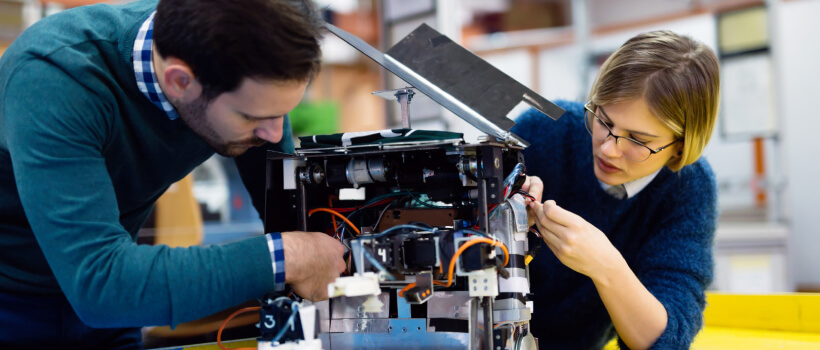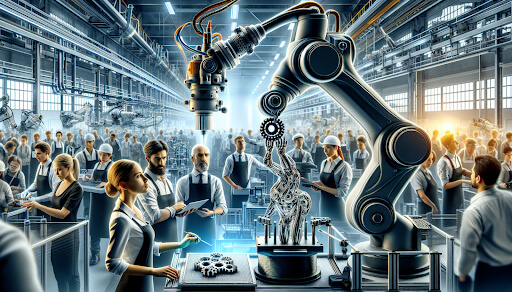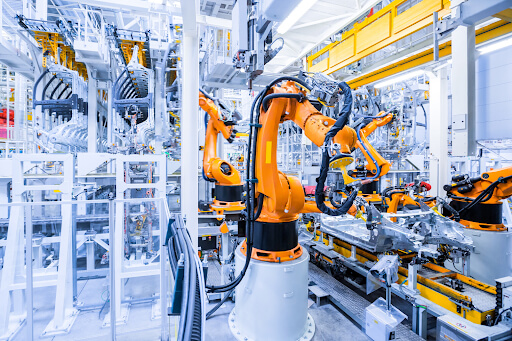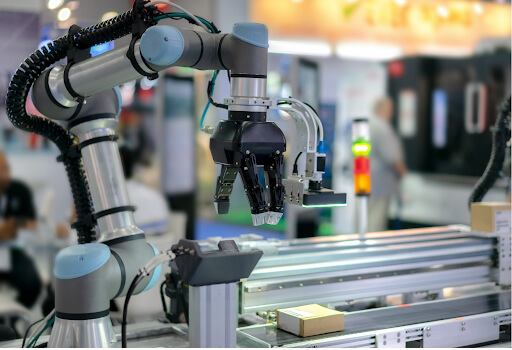 1-800-805-5783
1-800-805-5783 
With digital transformation, robotics in manufacturing has revolutionized the way industries operate, leading to unprecedented efficiency, reduced errors, and enhanced productivity. As robots become integral to production lines, performing tasks once solely the domain of humans, the shift towards automation within Industry 4.0 heralds a new era of industrial production. This transformation not only paves the way for increased productivity but also, contrary to concerns, potentially revitalizes manufacturing in developed countries without significantly impacting structural unemployment.
Integrating 3D printing in manufacturing alongside robotics represents a synergy that could further redefine production paradigms. These technologies, central to the concept of Automation and Industry 4.0, are moving the industry towards more customized, flexible manufacturing processes. As businesses navigate this transition, platforms like Shoplogix are instrumental in optimizing robotic operations, suggesting a future where automation and human ingenuity coalesce to meet the demands of modern production. This article will explore how robotics and 3D printing are transforming the landscape of industrial manufacturing, spotlighting challenges, opportunities, and future trends.
The robotics journey in manufacturing has been marked by significant milestones, each paving the way for the next leap in industrial innovation. From the inception of the first industrial robot in the 1950s, a two-ton machine developed by George Devol, to the advent of collaborative robots (cobots) designed to work alongside humans, the evolution has been both rapid and transformative.

Key Milestones in Robotics Evolution:
This progression of robotics in manufacturing underscores a shift from simple mechanical tasks to complex, precision-oriented operations facilitated by advancements in technology such as soft robotics, end-of-arm tooling, and the integration of AI. The synergy between robotics and 3D printing, exemplified by Boston Dynamics’ use of 3D printing in creating robot components, illustrates a future where manufacturing is about efficiency, innovation, and customization. As we look towards 2030, the expectation is for robotics to become even more ingrained in our daily lives and work, driven by the continuous evolution of AI and the Internet of Things (IoT), marking a new chapter in the industrial revolution.
The transformative impact of 3D printing in production cannot be overstated. It offers a spectrum of advantages, from accessibility to scalability. With printers available for under $800, the technology is not just for hobbyists but has scaled to meet the demands of mass prototyping and production. Despite its extensive application across aerospace, automotive, and medical industries, 3D printing faces limitations. Traditional methods like injection molding may still hold the economic upper hand for simple parts in large quantities.

As the frontier of industrial innovation expands, the intertwining of robotics and 3D printing brings a new era of manufacturing characterized by enhanced customization, efficiency, and functionality. This synergy is a technological advancement and a transformative force reshaping production landscapes.
This fusion of robotics and 3D printing is crafting a future where the boundaries of manufacturing are continually redefined, driven by the pursuit of efficiency, customization, and innovation.
In the dynamic landscape of 3D printing and robotics in manufacturing, collaboration emerges as a cornerstone for innovation. The fusion of expertise from diverse locations, facilitated by virtual meetings, underscores the importance of seamless communication. Despite the advantages, challenges such as time zone differences and cultural nuances necessitate robust strategies for effective collaboration. A streamlined Product Lifecycle Management (PLM) system, integrated with AI and generative design, can significantly enhance collaborative efforts, driving the pursuit of resource-efficient and innovative solutions.
Incorporating robotics into manufacturing introduces its own set of challenges and opportunities. Adapting new technologies requires staff reeducation, while the financial aspects, including material costs and technological maintenance, demand careful consideration. Robotics’ role in monitoring and optimizing the 3D printing process through AI algorithms represents a promising avenue for addressing operational challenges, highlighting the symbiotic relationship between these two transformative technologies.
In the realm of future trends and predictions, the synergy between robotics and 3D printing is poised to usher in transformative changes across various sectors. The following points underscore the anticipated advancements and their implications:
The projected growth of the global 3D Printing Robots Market, estimated to reach USD 4.9 billion by 2026, reflects the burgeoning integration of 3D printing in conventional manufacturing spheres. This growth indicates the increasing reliance on 3D printing for industrial applications and highlights the shift towards smarter, digital manufacturing paradigms. As industries like automobile, aerospace, and medicine increasingly adopt 3D printing, the relevance of this technology, alongside robotics, in manufacturing is set to soar, marking a new era of efficiency and innovation.

As the journey through the transformative role of robotics and 3D printing in manufacturing unfolds, it becomes evident that these technologies are not merely tools of efficiency but beacons of innovation, driving an industrial evolution towards greater customization, productivity, and sustainability. The robotics synthesis with 3D printing emerges as a powerful catalyst for redefining production processes, enabling the creation of complex, tailored solutions that were once thought to be beyond reach. This melding of capabilities underscores a future where the production lines are not just automated but are intelligent, versatile, and seamlessly integrated with human creativity and ingenuity.
Looking forward, the implications of such advancements extend far beyond the manufacturing floor, promising to bring about a significant impact on economies, job markets, and societal needs. The continuous evolution of these technologies suggests a path toward an increasingly digital, efficient, and personalized manufacturing landscape. Further research and innovation in these fields will be crucial in overcoming current limitations and unlocking the full potential of robotics and 3D printing in manufacturing, thereby propelling industries into a new era of operational excellence and product innovation.
3D printing is a key tool for robotics manufacturers, particularly for producing custom parts. Additionally, it is instrumental in repairing robots by enabling the on-demand creation of replacement parts and spares. These parts can be reverse-engineered and enhanced to rectify issues with existing components and designs.
3D printing plays a crucial role in manufacturing by slashing costs and dramatically reducing lead times from weeks to hours, enhancing operational flexibility. It presents industrial manufacturers with innovative methods to refine manufacturing processes, develop novel business models, and foster innovation.
Robotics in manufacturing is predominantly utilized for a variety of tasks. These tasks can be categorized into three main groups: material handling, processing operations, and assembly and inspection. Examples of material handling include transferring materials and loading or unloading machines.
Industrial robots are revolutionizing the manufacturing industry by significantly boosting productivity. They can operate at speeds surpassing human capabilities and work continuously without fatigue, delivering a substantial uptick in production output.
[x]cube LABS’s teams of product owners and experts have worked with global brands such as Panini, Mann+Hummel, tradeMONSTER, and others to deliver over 950 successful digital products, resulting in the creation of new digital revenue lines and entirely new businesses. With over 30 global product design and development awards, [x]cube LABS has established itself among global enterprises’ top digital transformation partners.
Why work with [x]cube LABS?
Our co-founders and tech architects are deeply involved in projects and are unafraid to get their hands dirty.
Our tech leaders have spent decades solving complex technical problems. Having them on your project is like instantly plugging into thousands of person-hours of real-life experience.
We are obsessed with crafting top-quality products. We hire only the best hands-on talent. We train them like Navy Seals to meet our standards of software craftsmanship.
Eye on the puck. We constantly research and stay up-to-speed with the best technology has to offer.
Our CI/CD tools ensure strict quality checks to ensure the code in your project is top-notch.
Contact us to discuss your digital innovation plans, and our experts would be happy to schedule a free consultation.